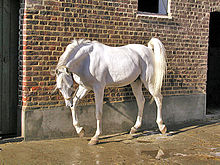Al Khamsa
Al Khamsa are the five obedient mares of Muhammad, also Arabic الخمسة al-Chamsa called 'the five'. You are a legend from Islam .
According to the story, in 622 the Prophet Mohammed and his companions were caught in a sandstorm while migrating Hijra from Mecca to Medina . His caravan came to a well in the evening, but when the exhausted and thirsty horses rushed off, they called Mohammed back. Only five mares dutifully turned back, whereupon Mohammed blessed them and everyone put their thumbs on the neck, where small swirls of hair then formed.
Those swirls of hair are still called the thumbs of the prophet today and the horses that own it are said to be particularly noble. With those five horses, Mohammed founded a breed interspersed with religious beliefs , of which the noblest lines are said to go back to the Al Khamsa ("the five").
According to a variant of the legend, Mohammed deliberately let a herd of mares thirst for days with the same result before opening the pen. The five mares who listened to his command and did not gallop to the watering hole were given special names and, according to legend, founded the breeding lines of Al Khamsa .
Breeding lines
According to legend, five mare lines of the Arabian thoroughbred go back to Al Khamsa. On Arabic websites, the lines can only be verified as breeding lines, but not as mares at the time of the Hijra.
For each mare line, also called stem, there are several spellings, depending on which way the name has taken to us.
| Tribe (arabic) |
Mare line | Synonyms | origin | features | descended races |
image | |
|---|---|---|---|---|---|---|---|
| كحيلان | Kuhailan | Koheilan, Kuhaylah | Saudi Arabia , Iran , a mare line is called Haifi | rather large and sturdy, up to 152 cm, supposedly owes its name to their eyes, which, due to the black skin, look like they were drawn with kôhl , but there are foxes, molds and browns | Shagya , Tersker | ||
| عبيان | Abeya | ʿAbyan, Abayyah, Obeya, Abéyeh | Yemen | small, around 147 cm, mostly gray with markings | |||
| صقلاوي | Saqlawiyah | Saqlawi, Saglawi, Siglavy, Seglawi, Seglawie, Seklavi, Saklawiyah, сиглави | Bred by the Ruwallah (tribe from Northern Arabia and the Syrian Desert ) and the `Anizah , an important line is called Saqlawi-Jedran (also Gidran) | rather small (147–152 cm), mostly brown, very noble and persistent | Lipizzaner , Shagya , Gidran |

Hamrah from the Saqlawi-Jedran line, drawn by the `Anizah, acquired near the Euphrates , before 1909
|
|
| حمداني | Hamdaniyah | Hamdani, Hamdaniyya, Hamdanieh | Syria , today also: Tunisia , Iran | tall and sporty, 148 to 157 cm, straight head, gray and brown | |||
| هدبان | Hadbah | Hadba, Hedban, Hadban | Bred by the Ruwallah (tribe from Northern Arabia and the Syrian Desert ) and the `Anizah , mainly Iran today | around 150 cm, strong bones, well muscled, brown and black-brown, few markings, calm character |
Carl Raswan , writer and promoter of the Arabian horse in the middle of the 20th century, was convinced that there are only three mare lines: Koheilan, Saglawi and Muniqi. Raswan describes the Koheilan tribe as masculine, Saglawi as feminine and Muniqi as particularly quick. There are other lesser-known lines. The line purity was taken very seriously by the Bedouins.
literature
- Henrietta Siksek: The Gallant Five. RB Luce 1963.
Individual evidence
- ^ Jean Power: Sons of the Desert. The Arab Horse in History, Mythology, Poetry, and Pictures. Delta Books 1980, p. 32 ( books.google.de ).
- ↑ Hedvig Ujvári: Between Bazaar and world politics. The Vienna World Exhibition in 1873 in Max Nordau's feature pages in “Pester Lloyd”. Frank & Timme, Berlin 2011, ISBN 978-3-86596-336-9 , p. 230, note 208.
- ↑ Fire in the Heart , Culture Magazine ( Memento from May 29, 2013 in the Internet Archive )
- ↑ Carl Reinhard Raswan, Hans Seydel: The Arab and his horse. Olms, Hildesheim 1998, ISBN 3-487-08234-9 , p. 27.
- ^ Al Khamsa Organization: The Horse of the Bedouin. ( Memento from November 19, 2010 in the Internet Archive )
- ↑ Derry Bred for Perfection. Pp. 104-105.
- ^ Arabian Horse Association: Arabian Horse History & Heritage - Horse of the Desert Bedouin. ( Memento from April 22, 2006 in the Internet Archive )
- ↑ Some ways of the English-language horse breeding and equestrian sports terms translation into the Russian language ( Memento from December 20, 2016 in the Internet Archive ) Authors: Раздуев Алексей Валерьевич and Мамина Анастасия Владимировна, p. 15, 2015, Vienna.
- ↑ Al Khamsa Organization: The Bedouin Concept of Asil ( Memento from November 19, 2010 in the Internet Archive )
- ^ The Arabian: War Horse to Show Horse, Gladys Brown Edwards, 1973, Rich Publishing, Covina, California

